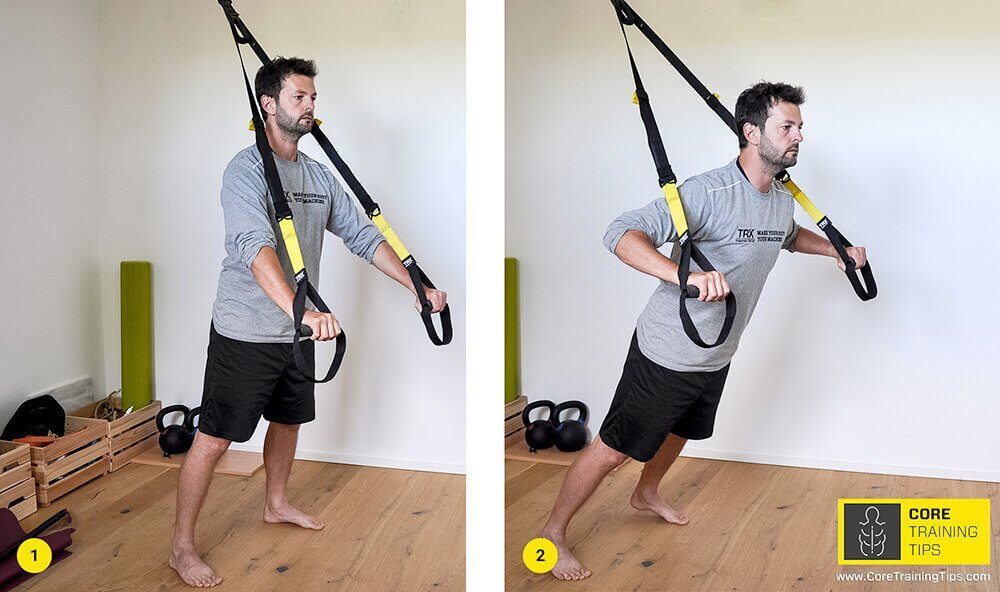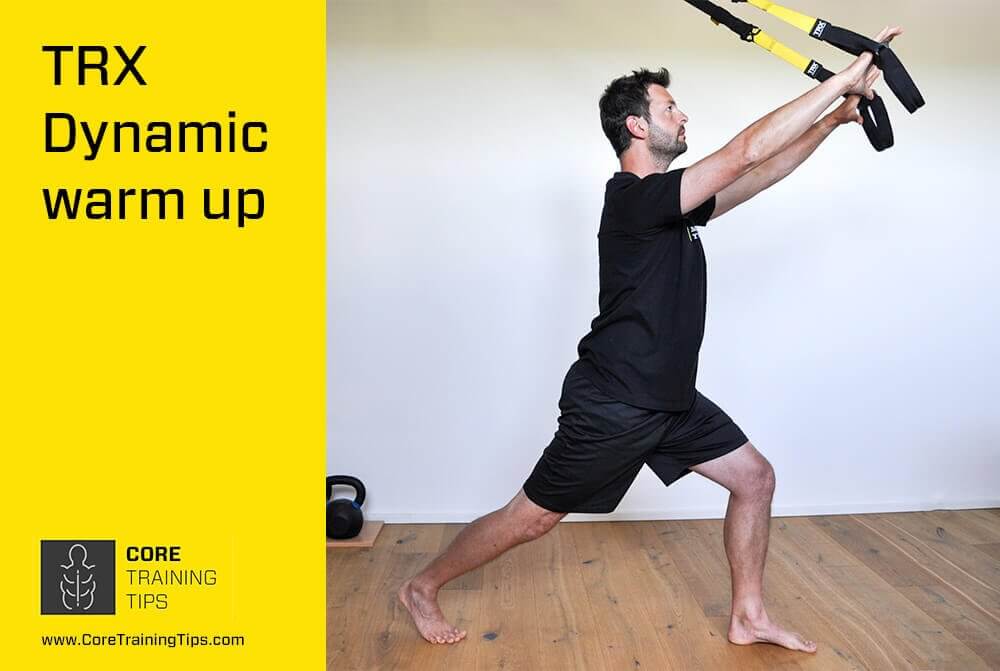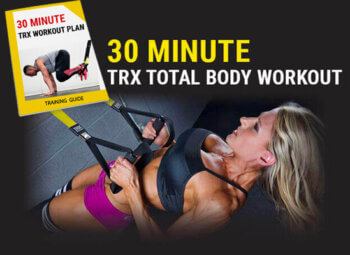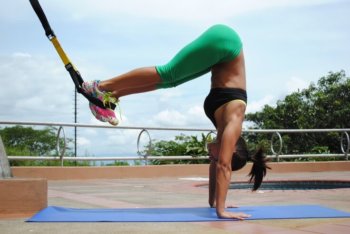
🎁 How to apply the TRX Training Discount Code

Among athletes and gym goers of all levels, there’s often some confusion about the exact differences between TRX training (or suspension training), and resistance band training. Both involve the use of similar looking equipment, essentially straps, and both are used for a broad range of exercises as an alternative to free weights or plate loaded machines.
There’s also a degree of rivalry between fans of the two training methods, with each side claiming their system is more effective. In truth though, there are a number of significant differences between the two workout styles, and depending on your individual goals, each has its own advantages and disadvantages.

What is better: resistance bands or TRX suspension training?
In this article, we’ll try to put the question to rest by taking an unbiased look at both resistance band training and TRX training, assessing where each method is most effective, the context in which it is used, and the pros and cons for different types of athlete. We hope this will assist our readers in identifying the best method of training for their individual needs.
Let’s start with a closer look at each of the two workout methods, and define how each one works, and what type of exercises are possible with each.
What Is TRX Training?
TRX is the brand name of a suspension training system which was developed in the early 2000’s by Randy Hetrick, who is a fitness expert and a former Navy Seal Squadron Commander. Hetrick developed the principles of suspension training using a self designed setup which he created from parachute webbing and a martial arts belt whilst on deployment with the Seals.

TRX FORCE tactical conditioning program
Having left the service, he created a more professional version, suitable for general sale which he branded as the TRX system.
TRX remains the market leader in suspension training equipment, although other manufacturers have since developed similar product offerings.

How was the TRX Suspension Trainer created?
Randy Hetrick is the creator of the TRX Suspension Trainer, but….the elements of modern exercise philosophy known as suspension training have existed in various forms already for hundreds of years.
Suspension training works on a simple principle. It uses fixed length straps to anchor and support the body in a variety of positions, which allow the user to complete a greater range of bodyweight exercises, and work on a wider set of muscle groups than would be possible using a mat or bench alone.
The basic setup consists of a set of two straps, each with a handle on the end, which can be attached to various anchor points. Most sets will also include accessories such as cuffs to allow the straps to be attached to the feet, ankles, or other parts of the body, thereby increasing the number of different exercises available.

🎁 How to apply the TRX Training Discount Code

What Is Resistance Training?
Resistance training has been around in one form or another since the early part of the twentieth century. Initially made from rubber, resistance bands were used as a more portable alternative to free weights, and also were common in the field of physical therapy to facilitate low impact exercises.
With modern developments in textile technology, most resistance bands currently available on the market are manufactured from a fabric and latex blend which is more hard wearing, tear resistant and allows for a better grip, such as the ones available at this link.

Resistance bands workouts
Two main types are available, a flat loop shaped band, and a hollow tube shaped band with handles at each end. Bands of both types can be manufactured with different levels of resistance, and are usually color coded to indicate the level – although the specific meaning of color codes varies between manufacturers.
Unlike in suspension training, the bands aren’t used to support the body, but rather to provide resistance.
There are a wide variety of potential exercises, using the resistance bands to isolate and train individual muscle groups. Many of these are adapted from existing bodyweight exercises and make use of the resistance band to add additional muscle load, for example, banded squats or banded push ups.
In other cases, the resistance of the band may be used to assist the user, such as in banded pull ups, where the band is used to help novices develop strength and technique by reducing the effort needed to lift their chin over the bar.
Advantages Of TRX Training
One benefit of TRX suspension training is that it uses the person’s body weight to provide load to the muscles during a workout. By varying the angle of suspension or the anchor point, the relative load can be varied.

TRX muscles worked while exercising
This allows for a substantial range of weight to be placed on the different muscle groups, and means that the load is relative to the person’s own muscle mass to a certain degree – as you build muscle, the difficulty increases along with your strength.
The nature of the exercises leads to another advantage which suspension training has over resistance bands – building core strength. Basically, every type of exercise in TRX training requires the core to be engaged to maintain position, so it encourages and facilitates the development of core strength – whatever type of workout you choose.

TRX vs. Weight training: The Full Comparison
Can TRX replace weight training? Is TRX effective for building muscle? To diffuse the confusion, I have put together an extensive TRX vs dumbbells guide.
Disadvantages Of TRX Training
Portability can be an issue with TRX equipment. Although it is obviously less bulky than a set of free weights, the kit required is much heavier than a resistance band. Similarly, suspension training requires a secure anchor point capable of supporting your whole body weight, so there are limits to where they can be performed.

TRX straps vs resistance bands
The “whole body” nature of suspension training, as discussed above, is great for building core strength, but this also introduces a disadvantage, in that it is difficult to isolate and train specific muscle groups, or to eliminate particular muscles, as you might do when recovering from injury. This makes it a little less flexible than resistance band training.
Advantages Of Resistance Training
One unique feature of resistance band training in which it differs from both suspension training and weight training is that the load on the muscles varies during an exercise or movement, which can help to prevent injury.
For example, in a bicep curl, the maximum load is present through each phase of the lift, whereas with a banded bicep curl, the resistance is low at the beginning of the movement, peaking when the bicep is fully contracted, and gradually lowers again as it is released.
Resistance bands are also much better than suspension training when it comes to isolating specific muscle groups, as the resistance can be applied in any plane, not only the vertical. This allows a greater variety of exercises to be performed from a standing position rather than requiring the use of mats or benches.
And of course, as mentioned above, most resistance bands, when coiled up tightly, can fit in the palm of one hand, or a pocket. This makes resistance band training a popular choice for working out on the move, as the bands can easily be transported to the park, the beach, or used in restricted settings such as a hotel room while traveling.
Disadvantages Of Resistance Training
Even with multiple “strengths” of band available, there is a limit on how much muscle load can be achieved through the use of resistance bands, and at the higher end of weight training, fixed machines or free weights are able to provide greater resistance, as well as suspension training to some extent.
Another issue with resistance band training comes from the band itself. Depending on the range of movement required for a particular exercise, the band can get in the way of the movement. This can be mitigated to some extent by carefully planning the exercises, but it does mean that some workouts are better suited to using weights or TRX trainers.
Conclusion
So, when you look at them in detail side by side, it’s clear to see that both resistance band training and TRX training have pros and cons, depending on exactly:
- what kind of workout you want
- where you want to exercise
- your personal training goals.
There’s no answer to the question “Which is better?”, but it is possible to work out “Which is better for me, right now”.

Dynamic warm up exercises using TRX Suspension Trainer
Many athletes incorporate elements of both types of training into their routine so that they can make the most of the benefits of each method.
While that does involve spending a bit more initially, as you need to purchase two different sets of kit, in the long run, it gives you a lot more flexibility in terms of the range of exercises you can do.
What resistance band and TRX to buy?

🎁 How to apply the TRX Training Discount Code
At the end of the day, the most important consideration in choosing the right combination of exercises to most effectively meet your goals, whether that’s building core strength, muscle mass, stamina, or training specific muscle groups. The best method is always the one that lets you reach and exceed the targets you set yourself.












